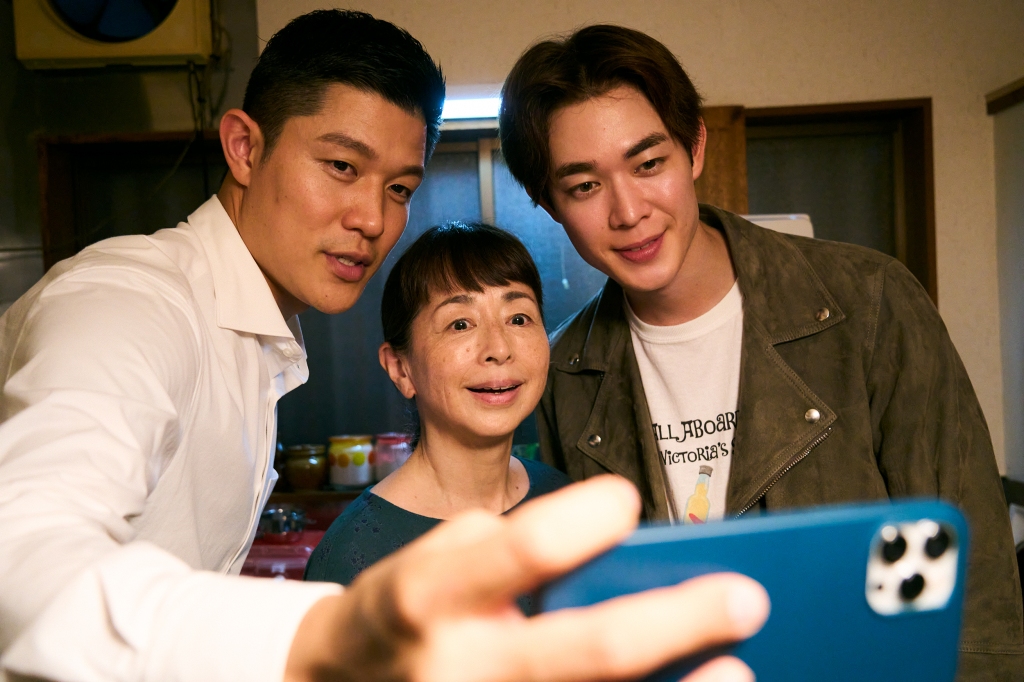Introduction
Within Japanese cinema, it is not surprising that a successful novel receives a movie-adaption. What is, nevertheless, surprising that the adaptation of Takayama Makoto’s semi-autobiographical novel Egoist by Daishi Matsunaga follows in less than one year after its publication. What message touched readers in the novel and necessitates a filmic adaptation?
Review
On the recommendation of his friends, Kosuke Saito (Ryohei Suzuki), an editor, contacts Ryuta Nakamura (Hio Miyazawa), a personal trainer who is just starting out. After their second training session, while climbing the stairs, Nakamura suddenly kisses Saito on the mouth. He confesses that he feels attracted to him.
While their romance appears to go smoothly, Nakamura suddenly confronts Saito with his wish to end things and stop meeting each other. While he tries to re-establish contact with Nakamura, he does not answer his phone. Yet, a ray of hope brightens his depressed morning when he finally discovers Nakamura’s profile on a call-boy site.
Matsunaga’s Egoist is a narrative that explores the way the imaginary field initiates as well as disturbs the romantic interactions between two subjects. To put it differently, Matsunaga shows that the imaginary field of relational happiness is often a tool in the subject’s arsenal to erase the lack at the level of the image.
The importance of the imaginary field is, straight away, highlighted in Egoist when Kosuke mentions that his designer clothes are like armour. Clothes – and this is something no one can deny – are utilized to reflect a certain image to the o/Other and influence how this o/Other perceives the subject. Yet, this social ego is not merely a construction to smoothen superficial interactions within the social field, but also a mechanism to keep the other at a distance from one’s subject. For Kosuke, his stylish outfits aimed at modulating the social field – the image created by clothing stands between the subject and the Other – so that his subject and his mother could avoid the verbal attacks by the bullying ‘pigs’.
The imaginary – and this should not surprise anyone – marks the field of romantic flattery and playful seduction. The signifiers, acts, and facial expressions utilized in such a game do not only echo the sexual interest of the speaker – the admiration of the other’s body/face is erotically motivated, but also aims to invite the other subject to reveal himself as an approachable sexual object. Of course, this game of eroticizing the other as image does not call any subject forth. As it merely aims at realizing a physical meeting of sexualized ego’s, the subject remains radically absent (Narra-note 1).
The demand to bring one’s subject into play, eventually, burst forth in the shape of Nakamura’s decision to ends things despite loving him (Narra-note 2). This quite shocking event does not only grant Saito a fleeting glance at Nakamura’s subjective struggle, but confronts him with his failure to encounter this struggle by bringing his subject into play within their quite physical romance. While the subjective weight of vocalizing the signifiers I like you and the act of buying him for himself for a monthly fee reestablishes their romance, these surges of subjectivity might not be enough to protect their mainly imaginary from other conflicts.
While the monetary gift reestablishes their romance, the act of buying his love and turning him, in a certain sense, into his personal prostitute is not without ramifications on their relational dynamic. Spectators will realize that, due to the dynamic of monetary gifts, their relationship remains stuck on the level of the imaginary. While many things around them change – events that are not without their subjective impact, the financial dependency of Nakamura creates a situation where the inter-subjective encounter is radically sabotaged (Narra-note 3). As the rhythm of financial gifts disallows Nakamura from lacking within his relationship with Saito, an irreducible emptiness keeps lingering within their heartwarming romantic interactions and the deceptive image of harmony they establish.
By highlighting the importance as well as the obstructive effects of imaginary field for their romance, we want to emphasize that something remains unrealized within their romance. Herein lies the veritable tragedy of their beautiful and genuine relationship.
Up until now, we’ve been avoiding one of the most important questions of Egoist: what is the function of the monetary gift for Saito? As the narrative unfolds, it becomes increasingly clear that the act of giving is nothing but an attempt to tightly secure the love of the other to satisfy his ‘egoistic’ need to feel loved. The very dynamic he installs is a response on the deep insecurity that blossomed in Saito after Nakamura’s initial refusal (Narra-note 4).
To simply call Matsunaga’s composition highly dynamic would do a disservice to his skill and his sense of rhythm. Matsunaga successfully juggles and balances a fluid and kind of poetic dynamism, one that emphasizes the style and energy of his main characters, with a more rougher documentary-like dynamism that subtly reverberates the autobiographical nature of the narrative. The result is a visual fabric that is both elegant, full of engaging visual rhythms, as realistic.
However, the function of the rougher dynamism is not limited to emphasizing the auto-biographical nature of the fictional narrative. The shakiness of the frame also ends up injecting realism into the expressed emotions and the conversational rhythms. The documentary-like style of framing, thus, invites us to consider the variety of emotions within the narrative as genuine and the conversational patterns as unfeigned (Cine-note 1). The scenes depicting sex also benefit from this visual decorative element. Rather than glorying the act and trying to arouse the spectator, the shakiness reverberates the sexual tension to reveal the Freudian drive as it is.
The main reason why the spectator gladly accepts Matsunaga’s subtle invitation is due to the natural and layered performances of the two leads, Ryohei Suzuki and Hio Miyazawa. It is due to their performance that one can feel the genuine nature of their imaginary romantic interactions – the emotions they share are heart-warming, while feeling the sadness of the romantic potential that is unable to fully blossom at the symbolic level.
Egoist, an exquisitely visualized fragment of Takayama Makoto’s personal trajectory, confronts the spectator an important glance at the complicated role the imaginary plays within the establishment of the romantic bond. Matsunaga’s heartfelt and heart-breaking narrative goes beyond the gay-dynamic to show that the lack that injures the subject complicates and radically determines the way he approaches the object of his ‘love’. As a result, the same field responsible for one’s relational happiness becomes the very cause of personal tragedy.
Notes
Narra-note 1: The spectator can feel this absence of subjects by asking himself what he knows about Saito and Nakamura. The realisation that he doesn’t know that much about them, a lack that mirrors the lack of subjective speech between them, emphasizes that their romance is, first and foremost, an imaginary affair of sexual desire.
Narra-note 2: The reason why he wants to break up is because his love for Saito complicates his night-time work as gay call-boy. The more he comes to desire Saito, the more difficult it is to call forth his sexual desire with his clients.
Narra-note 3: While the figure of the mother is important to both subjects – something Freud already noted in his writings – and subjective speech around this figure is vocalized, it never leads to a true inter-subjective moment, a moment where either both meet each other at the level of their lack or both clash with each other due to their lack.
Narra-note 4: The way he treats Nakamura’s mother in the second half of the film is function of the same dynamic. Yet, it should be evident that he does not merely want to attain a mother’s love, but that he, albeit only phantasmatically, wants to love his mother through her presence. He uses her to recuperate what he radically lost, while silencing her, as much as possible, as subject.
Cine-note 1: Certain emotional moments are stylistically strengthened by the use of slow-motion.






